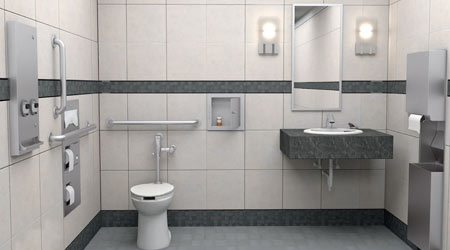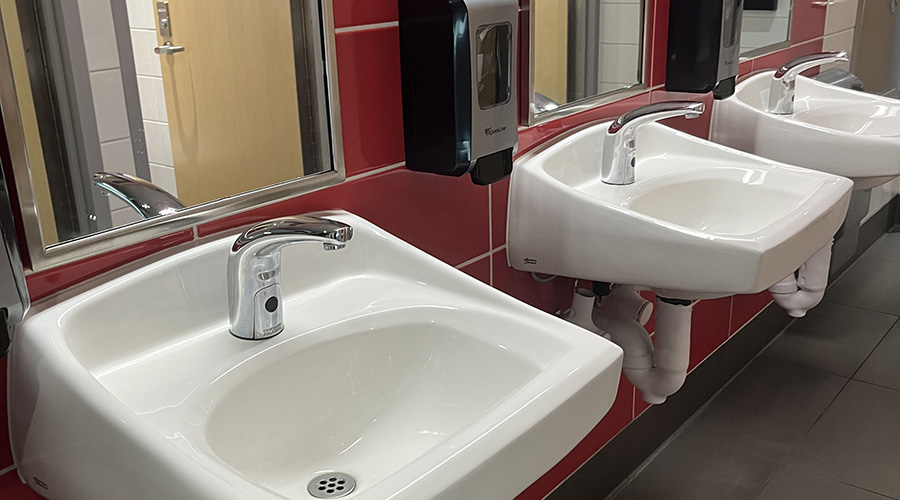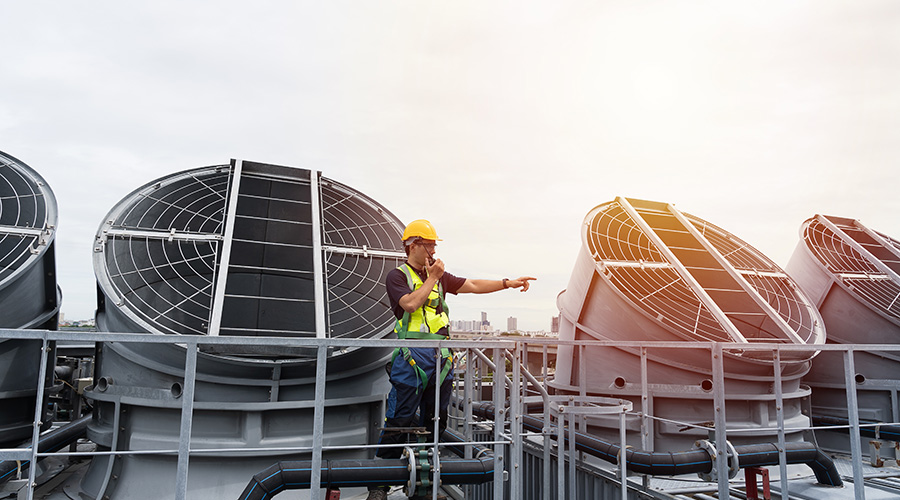 In a healthcare facility restroom, the concerns of safety, accessibility, and infection prevention loom even larger than they do in a standard public restroom.Photo courtesy of Bobrick Healthcare
In a healthcare facility restroom, the concerns of safety, accessibility, and infection prevention loom even larger than they do in a standard public restroom.Photo courtesy of Bobrick HealthcareNew Challenges in Healthcare Restroom Design, Operations
Rehabilitation facility restrooms present challenges, as does the increased focus on sustainability. Here are some tips for overcoming obstacles.
Rehabilitation facilities provide an extra challenge: the need to account more often for the possibility that two caregivers will be assisting one patient in the bathroom. What’s more, sinks and mirrors have to be designed to accommodate power wheelchairs.
For rehab facilities and for nursing homes, Fisher tries to make a point of minimizing the distance that the patient must travel, so that the head of the bed goes on the same wall as the bathroom door, with a grab bar in between. “That starts to affect how we lay out the whole room and how we stack the facility,” she says.
In a behavioral health unit, aesthetics must be balanced with the reality that, for suicide prevention purposes, it must be impossible to tie anything around any object in the bathroom – grab bar, sink, towel dispenser, even the door. Tile, too, must be avoided in case patients chip it and use it as a sharp edge. Mirrors must be unbreakable, and all corners must be rounded. “It’s amazing what people can invent or do to harm themselves,” Pinto-Alexander says.
Outpatient facilities can be designed to a lesser level of hard use, but they still benefit from good location and offering privacy for patients. “If it’s a multi-stall room, one or two need to be wide and have grab bars,” Bambery says. New construction is tending toward multiple one-toilet, unisex rooms.
In some outpatient settings, such as imaging, having a bathroom directly adjacent, without going into the hall, makes the patient’s life easier. Koloskov cites patients who have received barium enemas and pregnant women who, for best results on an ultrasound, need to do the procedure with a very full bladder.
New thinking
As in every other area of facility use, sustainability has become more important in recent years. Bambery says that more institutions are now installing two-stage toilets, with separate flushes for solid and liquid waste.
Cleanliness, hygiene, and infection-prevention, all working together, have to be the top priority in design, so it’s essential to be aware of what surfaces will be installed and how they are joined; porous grout nowadays is avoided in favor of smooth epoxy. Bambery says that part of the design is specifying every material to be used, with “specific language and details for literally every product material in the building.” Those materials may include antimicrobial surfaces, which keep germs from reproducing, but can also stand up to harsh cleaning.
Another method, Bambery says, is creating as many continuous surfaces as possible, such as curving floor materials up the wall — seams are harder to clean. One strategy is to use “seamless but decorative tile that’s extremely easy to clean,” Pinto-Alexander says.
Lighting is the key to a welcoming room, Pinto-Alexander says, and she has worked with lighting designers to design dual lights for the mirror and the ceiling that look soft but are still bright enough for the cleaners. Wall sconces for lights are another effective touch.
Lighting is an important way that hospitals try to make the overall environment more welcoming and less institutional, and that strategy also carries over to other restroom elements. Bambery says that small, square tiles are out, and larger, more home-like floor patterns are in. Shelves, too, make a bathroom seem more home-like, according to Pinto-Alexander, as a place to store patients’ own supplies: “Grooming yourself is such an important thing in the healing process.”
In labor and delivery facilities, Koloskov says, the deep tub with jets, which used to be in vogue, is rarer now because of infection concerns, but some facilities are suggesting that mothers sit in a large shower. Grab bars next to the toilet give them something to grip during contractions.
“There are a lot of similarities to how we approach design” between healthcare and hospitality settings, Pinto-Alexander says. “We’re doing everything to enhance the experience of the guest, like a home away from home.”
David Lewellen is a freelance writer who covers facility issues.
Email comments and questions to edward.sullivan@tradepress.com.
Related Topics:













